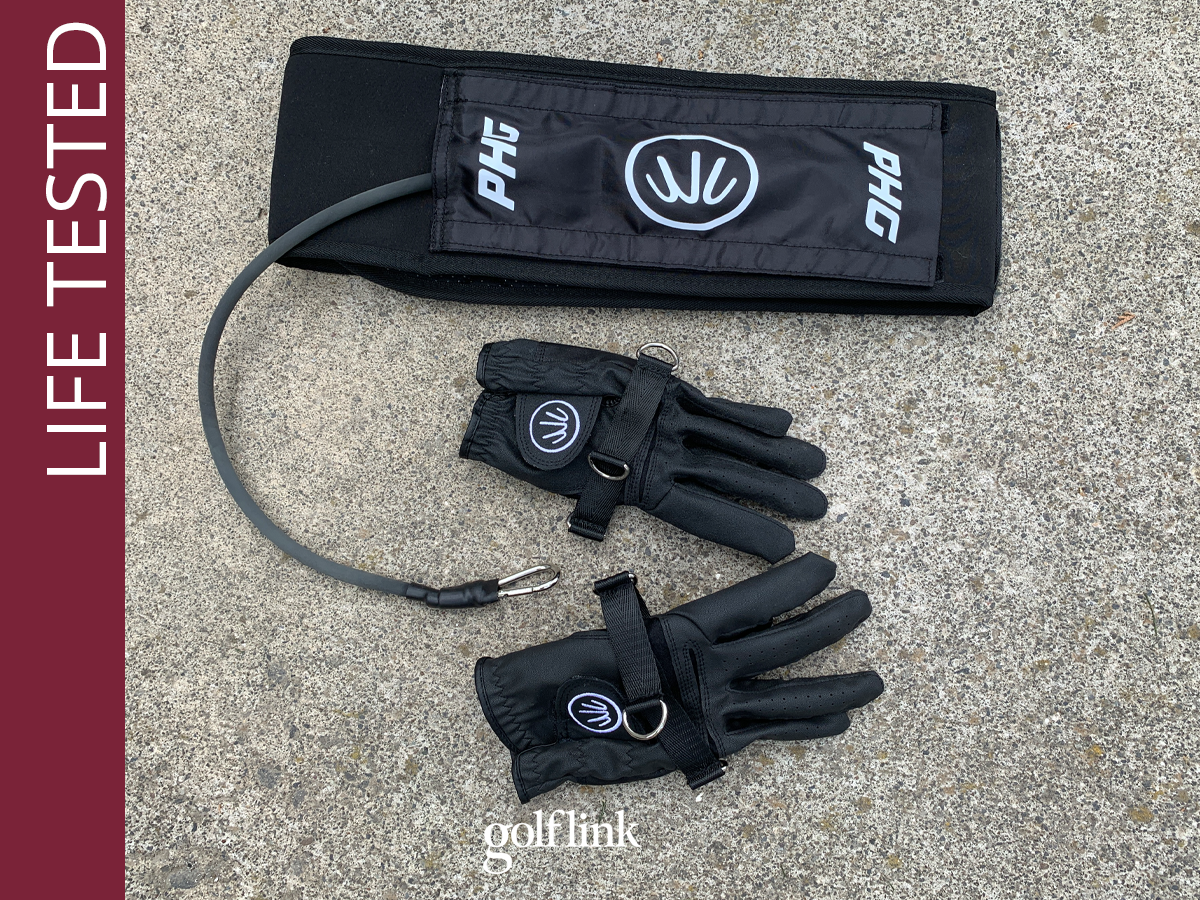Does Perfect Hands Golf Really Work? Here Are My Results
I followed the Perfect Hands Golf recommended training for 2 months. Here are my results.

Like all golf training aids, Perfect Hands Golf makes some bold claims. If you watch the video featured on their website, you’ll hear this one: “We guarantee you’ll see a minimum increase of 8-10 miles per hour of clubhead speed and an enhanced level of on-plane efficiency within 4-6 weeks by following the recommended training.”
That line grabbed my attention. I wasn’t sold by that promise. My reaction was more “prove it.”
So I contacted Perfect Hands Golf (PHG) and said I wanted to go through the recommended training – not for a day or a week, but for a couple months – to measure and publish the results to prove or disprove their claims. PHG enthusiastically agreed, which was my first indication that there was reason for the confidence behind those claims.
I spent two months training with PHG almost daily. I took baseline measurements before my first training session, then pulled several on-course and launch monitor stats to analyze the impact of PHG, and to find out if those claims are fact or fiction. Here’s my complete, life-tested Perfect Hands Golf review.
Perfect Hands Golf Pros & Cons

Pros:
- Remarkable distance improvements (literally, several playing partners have remarked on my distance gains)
- Gain of 8 mph club head speed and 23 yards of driver distance in 2 months
- Significant improvement in clubface control and overall less curve on shots
- Training sessions are short and simple
- Easy on the body
Cons:
- Instructions should be more clear, including the addition of a video series to help use the product correctly and get the most out of training sessions
- Everyday use is prescribed
- “Tin Cup” element to strapping on the belt, resistance band, and clipping it to a glove
Fact-Checking Perfect Hands Golf Claims

Let’s start with the biggest, boldest claim that PHG makes, a guarantee of a minimum increase of 8-10 miles per hour of clubhead speed and an enhanced level of on-plane efficiency.
Each mile per hour of clubhead speed translates to 2-3 yards of distance, depending on quality of strike. Using that math, PHG promises you about an extra 20 yards of distance. That’s a huge promise.
Before unpacking my PHG unit, my average swing speed was 99-100 mph, touching 103 once when swinging as hard as I could. Given those numbers, and skewing more towards top-end speed than average fairway-finder speed, my baseline swing speed was 102 mph.
After using PHG for two months I re-evaluated my swing on the same simulator and cracked 110 mph several times – touching 111 mph once – with several more swings at 109 mph. Considering outliers and consistency, I had a new top-end swing speed of 110 mph, eight mph faster than my previous top-end speed.
This increase in clubhead speed translated to the course. Using Shot Scope to track every shot I hit, I saw huge distance gains across the board. My average distance minus outliers (Shot Scope’s P-Avg stat) improved from 249 yards in 2023 to 272 yards since using PHG. Yes, I’m hitting the ball 23 yards farther.
My true average, including tops, shanks, and shots that ricochet off a tree 20 yards from the tee box (not that I would ever do that) improved from 203 yards to 247 yards, and my longest drive improved from 285 yards in 2023 to 292 so far in 2024.
Perhaps most satisfying of all is that every partner I’ve had who knows my game has remarked about how far I’m hitting the ball.
What about the promise of a more on-plane swing? I measured that, too. My path was incredibly neutral the day I collected my baselines, with all but one swing measuring less than one degree inside-out. However, my tendency is to hook the ball thanks to a clubface that’s closed in relation to a severely in-to-out path, so I began training with PHG in the cure a hook setting. After a few weeks, I noticed my ball flight became more of a slight push than a hook, which told me it was time to move to the neutral setting.
When I measured my path after two months of using PHG, my path measured more in-to-out than before, as there was almost no room for it to become more neutral than my baseline. However, it proved to be incredibly consistent, and averaged just over 2-degrees in-to-out.
I haven’t seen PHG make any promises to improve clubface control, but I couldn’t help but notice that in my before testing, my clubface was an average of 3.4 degrees from neutral, but in my after testing, it averaged less than one degree from neutral (0.8). Not only did my clubface average out to a very neutral number, but 9-out-of-11 swings were 0.6 degrees or less from neutral (all open), and none were more than 3-degrees from neutral.
Since I haven’t seen PHG claim to improve clubface control, I don’t know whether to chalk this up to the training aid or not, but I haven’t done anything else that would improve any part of my swing since I started testing PHG.
The result on the course is straighter shots. Not every shot splits the fairway, there are still pushes and pulls, but there is so much less curve than before. Pushes don’t turn into slices, pulls don’t turn into hooks. As a result, according to my Shot Scope data, I’m hitting 10% more fairways with driver in 2024 than 2023, and when I miss, I’m three yards closer to the fairway than before.
I can’t sign off on PHG’s claim that it can cure slices and hooks. To me, that’s almost as big of a reach as promises to eliminate 3-putts forever. They’re always lurking if you let your guard down. That said, if you struggle with a slice or a hook, I highly recommend PHG. You will notice less curve, straighter shots, and a tighter dispersion. I can sign off on that.
|
Before |
After |
|
|
Average Driver Distance |
249 yards |
272 yards |
|
Longest Drive |
285 yards |
292 yards |
|
Swing Speed |
102 mph |
110 mph |
|
Swing Path |
1.3 inside-out |
2.1 inside-out |
|
Club Face / Tendency |
3.4 degrees / open |
0.8 degrees / open |
Perfect Hands Golf Review
Okay, we’ve fact-checked PHG’s claims, and I’ll be honest, it’s transformed my game more than anything else has in the last decade, including lessons, books, videos, and other training aids. Yes, it’s that good. But we still need to talk about what exactly PHG is, and how to use it.
I think of Perfect Hands as a bit of a Tin Cup training aid. Think of the scene where Kevin Costner has all sorts of gadgets hooked up to his body from head to toe as he desperately works on his mechanics, while from the outside, he looks like a complete lunatic.
PHG is not that extreme, but it has that element. You strap a big belt around your belly, which clips to a resistance band, which then clips to a special glove with three settings: neutral, slice fix, and hook fix.
Once you’re strapped in, the training protocol has you swing a club as far back as you can and as hard as you ever would on the course, repeating that swing in a pendulum rhythm until you tire or lose balance.
When you’re done with your dominant hand, flip it around and swing with your non-dominant side. For those with close-by neighbors who train with PHG in the backyard, those non-dominant PHG swings are your peak Tin Cup moment.
Once you can make 50+ swings with your dominant hand without getting tired, you move up to the next resistance band (four bands are included).
The training is pretty straightforward, but it took me a while to learn the limits. When I first began using PHG, I swung past the point of getting “tired” in an effort to graduate to the next band faster.
We all have different definitions of “tired” and anytime you use a resistance band and swing a club as hard as you can, there’s an expectation that your heart rate will increase and you’ll get winded before long. That’s why I think the definition of when to end each training session should be more clear.
I also hoped to find some training videos on YouTube when I first started using PHG, to make sure I was doing it correctly, but the training recommendations came up short in that area as well.
I brought both of these items up to Mario Karagiannis, the inventor and founder of PHG, and apparently, I wasn’t the first one. He set my training straight and assured me that these improvements are already in the works.
The training only takes about 5-10 minutes per day, which is easily short enough to fit it into any day. However, unlike many other speed training systems out there, PHG’s training is prescribed seven days a week.
I did my best to stick to that schedule, but as I expect many people will find, there were simply some days it wasn’t in the cards. Either because of snow, sick kids, or other demands, I averaged closer to six days a week of training. Still, I saw results consistent with what PHG promised.
Don't Think Just Swing
Don’t think, just swing is PHG’s slogan, which at first I thought was kind of a throw-away line. But now when I step up to a shot, I get it. I’m not worried about spraying the ball off the planet. I know it’s going to go reasonably straight, pretty far, and I’m going to find it. I don’t have to think about my swing. I can just swing, and swing with confidence.
I know there are players who simply won’t strap on a big belt, hook it to a resistance band, connect that to their glove, and go outside and make swings left and right-handed for the whole neighborhood to see. I get it. But I’m not one of those people.
If you can get over that Tin Cup factor, Perfect Hands Golf will fulfill its promise to unlock loads of distance with – let’s be honest – very minimal effort. In exchange for 5-10 minutes after lunch every day I’m bombing it 23 yards farther than ever before, and straighter to boot, flirting with the first 300-yard drives of my life.
Maybe your results will vary, but despite PHG’s claims, I didn’t expect to see this much improvement in such a short period of time. After a thorough, data-driven fact-finding mission, I’m happy to admit I was wrong.